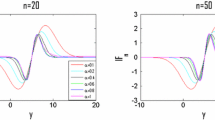Abstract
Bayes estimation of the number of signals, q, based on a binomial prior distribution is studied. It is found that the Bayes estimate depends on the eigenvalues of the sample covariance matrix S for white-noise case and the eigenvalues of the matrix S 2 (S 1+A)−1 for the colored-noise case, where S 1 is the sample covariance matrix of observations consisting only noise, S 2 the sample covariance matrix of observations consisting both noise and signals and A is some positive definite matrix. Posterior distributions for both the cases are derived by expanding zonal polynomial in terms of monomial symmetric functions and using some of the important formulae of James (1964, Ann. Math. Statist., 35, 475–501).
Similar content being viewed by others
References
Akaike, H. (1972). Information theory and an extension of the maximum likelihood principle, Proc. Second International Symposium on Information Theory, Supp. to Problems of Control and Information Theory, 267–281.
Anderson, T. W. (1963). Asymptotic theory for principal component analysis, Ann. Math. Statist., 34, 122–148.
Anderson, T. W. (1984). An Introduction to Multivariate Statistical Analysis, Wiley, New York.
Constantine, A. G. (1963). Some non-central distribution problems in multivariate analysis, Ann. Math. Statist., 34, 1270–1285.
Davis, A. W. (1979). Invariant polynomials with two matrix arguments extending the zonal polynomials: Application to multivariate distribution theory, Ann. Inst. Statist Math., 31, Vol. No. 465–485.
Gross, K. and Richards, D. (1987) Special functions of matrix argument I: Algebraic induction, zonal polynomials and hypergeometric functions, Trans. Amer. Math. Soc. 301, 781–811.
Hamedani, G. G. and Walter, G. G. (1988) Bayes estimation of the Binomial parameter n, Comm. Statist. A—Theory Methods, 17, 1829–1843.
Hayakawa, T. (1967) On the distribution of the maximum latent root of a positive definite symmetric random matrix, Ann. Inst. Statist. Math., 19, 1–17.
James, A. T. (1960). The distribution of the latent roots of the covariance matrix, Ann. Math. Statist., 31, 151–158.
James, A. T. (1964). Distributions of matrix variates and latent roots derived from normal samples, Ann. Math. Statist., 35, 475–501.
Khatri, C. G. and Pillai, K. C. S. (1968). On the noncentral distributions of two test criteria in multivariate analysis of variance, Ann. Math. Statist., 39, 215–226.
Krishmaiah, P. R. (1976). Some recent development on complex multivariate distributions, J. Multivariate Anal., 6, 1–30.
Kushner, H. B. (1985). On the expansion of C p *(V+I) as a sum of zonal polynomials, J. Multivariate Anal., 17, 84–98.
Kushner, H. B. (1988), The linearization of the product of two zonal polynomials, SIAM J. Math. Anal., 19, 687–717.
Kushner, H. B. and Meisner, M. (1984). Formulas for zonal polynomials, J. Multivariate Anal., 14, 336–347.
Muirhead, R. J. (1988). Zonal polynomials, Encyclopedia of Statistical Sciences, Vol. 8 (eds. S. Kotz, N. L. Johnson and C. B. Read), 676–682, Wiley, New York.
Parkhurst, A. M. and James, A. T. (1974). Zonal polynomials of order 1 through 12, Selected Tables in Mathematical Statistics (eds. H. L. Harter and D. B. Owen), 199–388, American Mathematical Society, Providence, Rhode Island.
Rao, C. R. (1983). Likelihood ratio tests for relationships between two covariance matrices, Studies in Econometric, Time Series and Multivariate Statistics (eds. T. Amemiya, S. Karlin and L. Goodman), Academic Press, New York.
Rissanen, J. (1978). Modeling by shortest data description, Automatica—J. IFAC, 14, 463–471.
Saw, J. G. (1977). Zonal polynomials: An alternative approach, J. Multivariate Anal., 7, 461–467.
Schwartz, G. (1978). Estimating the dimension of a model, Ann. Statist., 6, 461–464.
Wax, M. and Kailath, T. (1985). Determination of the number of signals by information theoretic criteria. IEEE Trans. Acoust. Speech Signal Process., 33, 387–392.
Zhao, L. C., Krishnaiah, P. R. and Bai, Z. D. (1986a). On detection of number of signals in presence of white noise, J. Multivariate Anal., 20, 1–25.
Zhao, L. C., Krishnaiah, P. R. and Bai, Z. D. (1986b). On detection of the number of signals when the noise covariance matrix is arbitrary, J. Multivariate Anal., 20, 26–49.
Author information
Authors and Affiliations
About this article
Cite this article
Bansal, N.K., Bhandary, M. Bayes estimation of number of signals. Ann Inst Stat Math 43, 227–243 (1991). https://doi.org/10.1007/BF00118633
Received:
Revised:
Issue Date:
DOI: https://doi.org/10.1007/BF00118633



